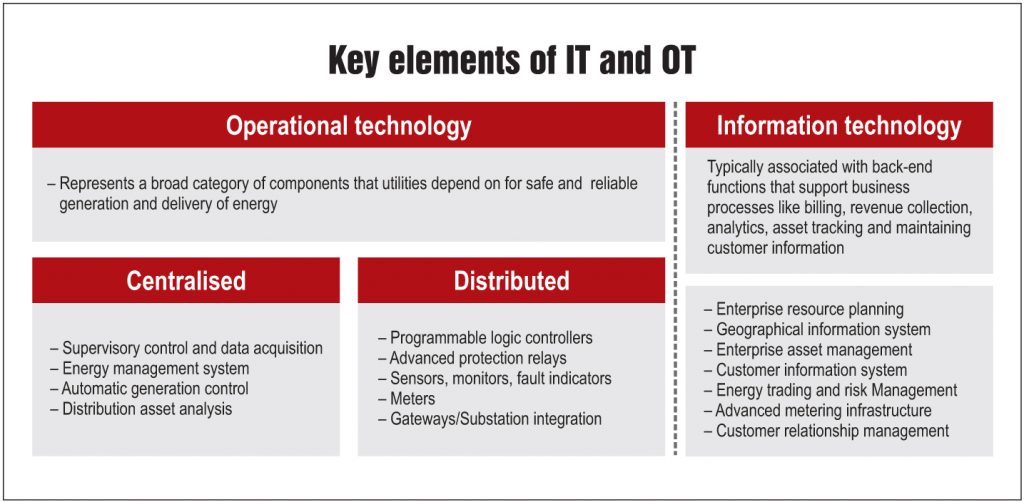
Over the past few years, there has been a significant increase in the use of information technology (IT) and new operational technologies (OT) in the power sector in India. The increase in the use of IT in public sector discoms has been driven primarily by the Restructured Accelerated Power Development and Reforms Programme (R-APDRP). The greater use of OT has also been made possible by funding from various government programmes. The private discoms too have been implementing these technologies driven by the need to reduce their technical and commercial losses and improve performance levels.
Historically, IT and OT have occupied separate realms in the power sector. However, in order to realise their full potential, utilities need to integrate operating technologies such as supervisory control and data acquisition (SCADA), distribution management systems (DMS), outage management system (OMS) and remote terminal units (RTUs) with IT systems that support metering, analytics, customer information systems, etc. This will lead to optimised business processes, better information for decision-making, more effective network management and improved customer service. While IT-OT convergence is not entirely new, there are more business and technology reasons now than in the past, which are driving the integration of the two technologies.
IT and OT applications
IT is traditionally associated with back-office information systems used for business transactions, such as accounting, billing and revenue collection, asset tracking, human resource records and customer records. Some of the applications include enterprise resource planning (ERP), advanced metering infrastructure (AMI), customer information systems (CIS) and geographic information system (GIS).
OT, on the other hand, is typically associated with field-based devices connected to the distribution system, and the infrastructure for monitoring and controlling those devices. This includes control-centre based systems such as SCADA and DMS. These technologies provide operational control of assets in the electric network in real time.
Key initiatives
Implementation of R-APDRP has been the most important initiative by the government to encourage the discoms for undertaking IT initiatives. The programme has now been subsumed under the Integrated Power Development Scheme (IPDS) which continues to focus on establishing IT-enabled services, including setting up of data centres and disaster recovery centres and rolling out of enterprise resource planning. The government has also approved the National Smart Grid Mission for planning, monitoring and implementation of programmes and policies related to the smart grid. Further, 14 smart grid pilot projects are being implemented, with partial funding from the power ministry, to deploy and demonstrate various smart grid technologies including AMI, peak load management and outage management.
Private discoms have also implemented a wide range of IT and OT such as ERP, SCADA, OMS, energy management system (EMS), optical fibre cable-based communication systems, surveillance systems, vehicle tracking systems and advanced analytics.
In the transmission segment, Power Grid Corporation of India Limited (Powergrid) is undertaking a Unified Real Time Dynamic State Measurement (URTDSM) project using the wide area measurement system (WAMS). It will help in real-time synchronised data acquisition across the country, which in turn will enable dynamic control, monitoring and management of the entire grid.
The state transmission utilities have also been actively adopting various measures including implementation of SCADA, AMI and GIS, installation of optical ground wire (OPGW) network and the establishment of central data centres.
In the generation segment, apart from SCADA and ERP systems, some companies have been using SAP (systems, applications and products) technology for the integration of various systems. It is being used to manage freight operations, record attendance of employees, assess merit order despatch and calculate availability-based tariff.
Further, a number of mobile-based applications have been developed recently for better information and more transparent communication. These include GARV Grameen Vidyutikaran app by Rural Electrification Corporation, Bijli Bazaar and Bijli Vyapar by PTC India for power traders, URJA by Power Finance Corporation on behalf of the power ministry and Vidhyut Pravah app by the Ministry of Power.
IT-OT integration
Metering was traditionally a part of the OT domain. Automatic meter reading (AMR) and AMI technologies, which emerged from OT are now connected to IT systems. Similarly, the emergence of various new technologies and business processes have been driving the integration of OT with IT systems.
Drivers
A number of smart devices including smart meters are being increasingly introduced into the market. Smart meters are a new class of remote terminal units with automated communications, remote controls, event logging and reporting. New types of assets like smart meters need to be integrated into the network and make them operation-ready.
Moreover, these devices generate a massive amount of data and drive requirements regarding data acquisition and management, as well as field maintenance.
Another factor driving the need for integration is the growing consumer engagement in grid operations. What started with reactive measures such as dynamic pricing to influence distribution of load at the consumers’ end has extended to include customer-owned renewable generation. While the scale of this generation is small in India as of now, it is likely to increase substantially in the next few years. This will require active engagement between the customer systems and grid control systems. Distributed generation and demand response management systems are examples of business applications that further increase the need to integrate the control centre with the customers.
The organisational demand for relevant information and the ability to support business decisions is growing exponentially. Grid and power distribution planners seek to optimise operations based on the data and information from meters and intelligent grid sensors. Similarly, consumers desire more detailed information on their energy usage, outages and restoration times. To address these and other information needs, integrated and combined data from multiple systems across both domains must be taken into account.
With these new requirements, the utility systems can no longer be seen as silos but need to work in an interconnected environment that enables and supports process optimisation, which will help faster decision-making. Further, shared standards and platforms across IT and OT can enable utilities to reduce costs across the software management landscape, including enterprise architecture, support and security models, and information and process integration. Similarly, by synchronising OT systems with cloud-based IT systems, utilities can achieve substantially lower operating costs along with an increase in power availability and flexible power management strategies.
Challenges
While the convergence of the two technologies can yield several benefits, it also poses certain risks. The increased interconnectivity makes the grid more vulnerable to cyber-security issues. As remotely deployed field devices are brought into connection with the IT domain, they open up new points of cyber attacks. Unlike IT systems, which are constantly updated with new releases and bug fixes, OT devices often run on the same software used at the time of initial installation. Moreover, such devices have limited security capabilities because they were installed at a time when the physical separation from the IT systems was considered to be secure enough.
Apart from cyber-security related issues, other challenges in integrating IT and OT include high costs, lack of interoperability and organisational issues.
Conclusion
While IT and OT systems have worked in isolation historically, in the past few years, a host of business factors and technological advancements have strengthened the case for the integration of the two technology systems. However, it remains constrained by a number of challenges. The issues can be overcome by the utilities by undertaking pilot projects. Such projects can be completed quickly, offer tangible and sustainable benefits, and most importantly, provide the learning and experience to implement similar projects on a larger scale and at a lower risk.
While, a number of technologies have already been implemented and integrated by various utilities, going ahead, the focus of the utilities will be on cloud-based solutions using big data analytics.

